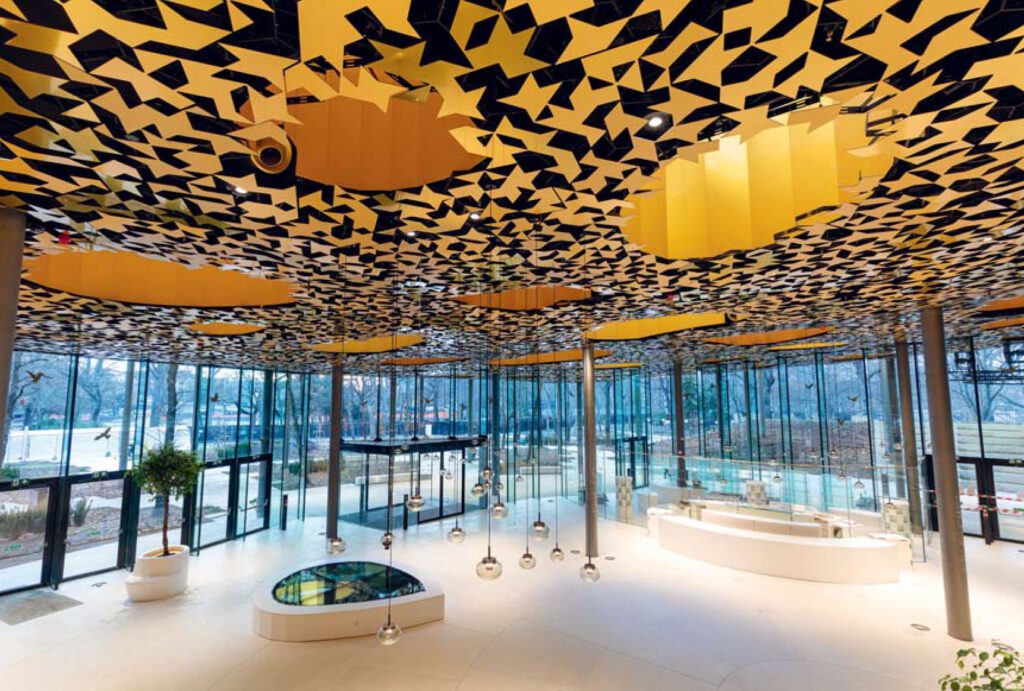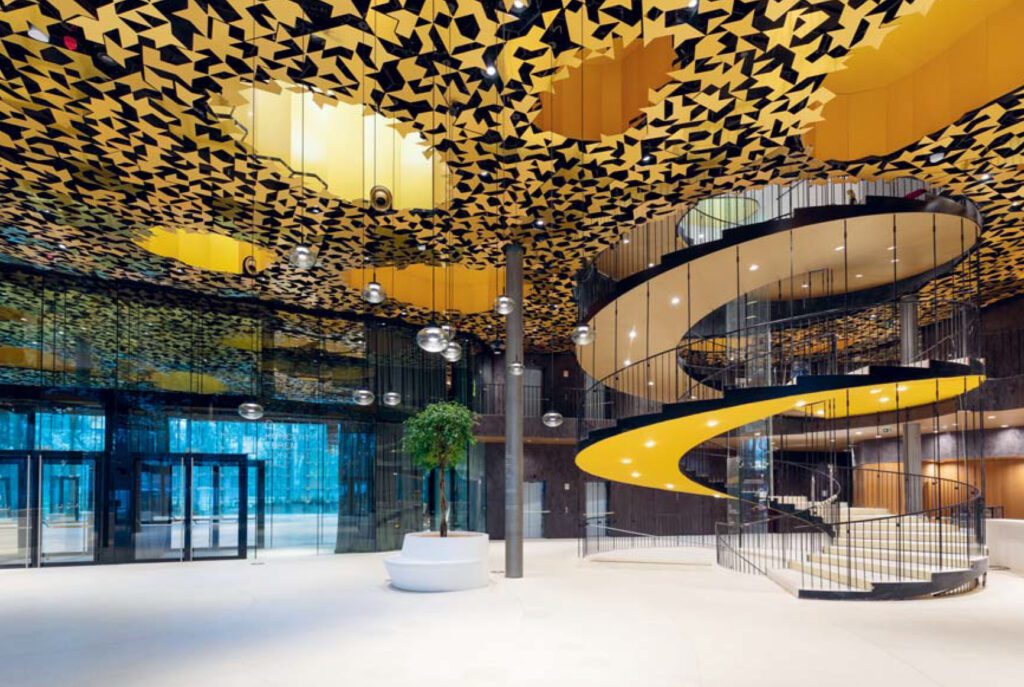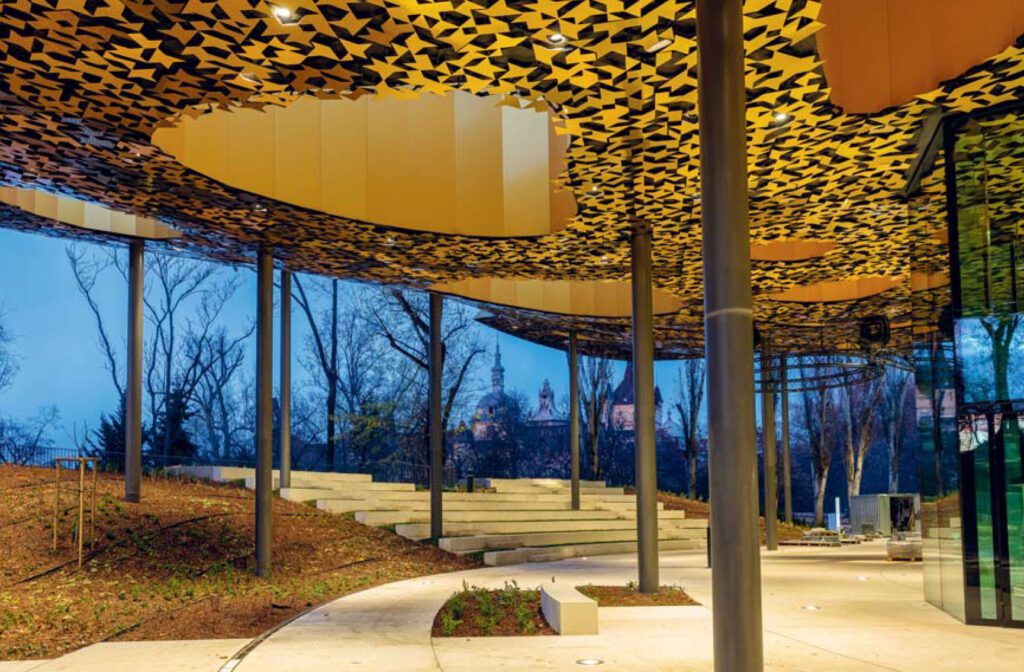Outside or Inside?
In the autumn of 2021, as a guest on the panel discussion on the topic ‘How to plan liveable cities for the future?’, the Japanese designer of the House of Music Hungary in City Park, Budapest, put it like this: The House of Music Hungary is being built in a park.
The first thing that came to my mind about this was that I was making music in nature. Consequently, I wanted to position the two auditoriums on the ground level so that they could communicate with the park. Whereas most concert halls are closed boxes, I dreamt up open spaces to be permeated by natural light, from where one can look out and see nature, and which one can also look into from outside, from City Park in this case. I wanted it to be a space with a liberating effect in a conceptual sense, and to offer, in practice, a high-quality experience of listening to music, also honouring the beauty of the surroundings. This commission created a rare, truly unique situation, something which would be simply unfeasible to implement anywhere else. To construct a glazed-wall space for music to be played in it is an enormous technical challenge. But we kept working on it until we managed to resolve all acoustic, structural, and other functional issues. I think when the building is completed, visitors will have quite a special place to discover.
Forest of Music was the title of the design concept proposed by Suo Fujimoto, in which he also expounded his ideal, according to which music and nature should indeed breathe together, while the building itself should be like the foliage of trees, letting the light through, but also offering shade and protection, ensuring freedom while protecting visitors—and the music—from external noises and the vagaries of the weather.
The outstanding Japanese architect earned his degree at the Technical University of Tokyo in 1994, and a few years later, he established the architectural office bearing his name. His first structures followed the modernism of the second half of the twentieth century, but this gradually gave way to the realization that, by conserving and transcending its ideals, Suo Fujimoto’s unusual treatment of

material and form was pushing the boundaries of architecture, trying to find ways of letting the constructed environment and nature meet and synchroni ze, and to deepen their symbiosis. This is what his grand-scale project of the Musashino Art University Museum & Library was about, along with the smaller but even more surprising transparent NA House in Tokyo, the seventeen-level branched L’Arbre Blanc (White Tree) apartment tower with balconies in Montpellier, imitating a tree and its leaves, the Serpentine Pavilion of London, assembled from white metal rods in 2013, and his bus stop in Krumbach, resembling a see-through forest.
I am now standing in front of the House. The transparent building blends softly into space, floating on its waves, between trees, immersed in light, radiating the architect’s faith which becomes even more palpable once the visitor steps inside: the intertwining and unification of architecture and nature, which evokes the line from Béla Balázs’s Bluebeard, ‘Just where is the stage? Outside or inside?’
My companion, Városliget Zrt’s technical deputy-CEO Attila Sághi, is speaking about the House of Music Hungary with the expertise and enthusiasm of an architectural expert, adding that the feasibility of the design was initially doubted by many. The building unquestionably posed major issues to be resolved during execution, but the construction team managed to meet the challenge, successfully implementing technical solutions which were unprecedented in the region.

Balázs Mohai
The studio M-Teampannon, headed by Tamás Noll, the Hungarian design and construction partner of Fujimoto Architects, had a key role in the completion of this architectural gem, which required special care and extraordinary precision.
Attila Sághi points out that the House reaches twelve metres in height at several points, but is still not as tall as the trees in and around it. He also mentions the ninety-four contiguous, unbroken glass facade units which ensure the transparency of this extraordinary structure, the organically floating roof held up by columns, evocative—visually—of waves of sound, apparently lacking any square elements, as well as the lightwells, almost one hundred in total, which lead natural light into the interior spaces, some of which are on the lowest levels. Some of the lightwells are in fact built around trees, leaving them sufficient space for further growth.
In the ground-floor lobby, the decoration of the suspended ceiling consisting of stylized leaves glimmering in the light with echoes of gold, and the similarly elegant suspended spiral staircase leading to the mezzanine and upstairs, are simply breathtaking. There are also concert halls on the level of the park, while exhibition spaces are positioned under the ground. Rooms of education and scientific research, as well as meeting rooms and offices, are accommodated upstairs. The sites of various activities are architecturally distinct, but thoroughly complement each other in terms of content.

BUDAPEST. Photo: Balázs Mohai
Let us take a top-down approach, says my companion. So, first, we walk up the terrazzo-covered stairs, of a width precisely determining the steps you are supposed to take. Upstairs, underneath the apparently irregular, or, to say the least, unusual roof, we find the sites of music pedagogy—a digital archive of the history of Hungarian pop music, first and foremost, a multimedia library and club, and an audio-visual studio—where children of any age, even groups of visitors from schools, can familiarize themselves playfully, as fits their degree of maturity, or, at a higher level, with music and musical instruments, and can take part in interactive creative programmes. If we step outside to the upstairs terraces, each of a unique shape, we can see the undulating, perforated roof almost from the level of the parapet, as well as the trees encased in holes of various dimensions and shapes extending beyond it.
After descending from upstairs, visitors are welcomed by a café on the mezzanine, similarly to the ground level, providing additional common-use space which can be visited irrespective of exhibitions, concerts, or educational programmes.
The astounding meeting of nature and constructed environment becomes complete in the grand auditorium on the ground floor. The multifunctional, fully-glazed concert hall can seat an audience of three hundred, with features including recessed stage equipment and an adjustable auditorium, breathing together with City Park, almost one with the greenery around it, the lake nearby, and Vajdahunyad Castle in the distance. The splendour of nature, therefore, can be the living stage set for all concerts in this magical space.
All this, however, is ‘only’ the visual effect; the big question was acoustics. The received wisdom was that sizeable glazed walls encasing a space are not the best solution, as sounds bounce back from them too sharply, almost ringing off them. But in this case, after acoustic measurements and trials, it appears that Nagata Acoustics succeeded in creating a perfect harmony between the qualities of what is to be seen and what is to be heard in here. As previously explained, the glass panes are not aligned to provide a flat surface, and are not flush, thereby ensuring that sounds are not thrown back directly, but are reflected in a dispersed manner. The metal leaves of the ceiling also contribute to creating the appropriate sound reverberations, and if more is required, textile curtains can also be employed. Acoustics—which can be considered quite good after all technical measurements and trials—can also be adjusted by increasing or decreasing the number of upholstered seats. The chamber room on the opposite side of the ground floor received some elements made of wood as well, in order to enhance the quality of sound there.
Going further down, under ground level, we can find the generously proportioned exhibition space. Its footprint of two thousand square metres exceeds that of the ground-level and upstairs installations—as a feat of the design, it does not occupy too large an area of the park, and does not overwhelm the environment, but is still capable of offering tremendous enjoyment with its themed exhibitions focused on the world of music. The exquisite feature here is the sound dome. A recessed cupola? Or perhaps a bell? Whatever you see in it, really. The main thing is what the visitor hears in the 360-degree projected space: the sounds of nature, and compositions. The magic of music. And here comes another wonder: the creative sound space in one of the small rooms where pitch, vibration, colour, and the rhythm of sound can be called forth. Play and learn—for the little ones as well as adults.
Regarding the permanent exhibition, visitors are assisted by an audio-guide, with sounds, snatches of music, and fragments of compositions, guiding them through the history of music, from the first sounds in the forest, birdsong, the whisper of leaves, folk music, lullabies, songs of mourning, to ecclesiastic music, from Gregorian plainsong to the birth of polyphony. The exhibition offers glimpses of the birth of the opera, a spectacular genre of passion, the music scene generously supported by monarchs in the seventeenth and eighteenth centuries, and the art of the great masters, including Bach, Haydn, Mozart, and Beethoven, as well as the evolution of Hungary’s national music and national opera throughout the periods of music history, presenting Erkel, Liszt, Bartók, and Kodály, along with twentieth-century innovators of modernist music, significant figures in pop music, composers of motion picture soundtracks, and the colourful contemporary music scene.
The first temporary exhibition is still some time away, but is to be opened in the near future to give us an interpretation of the history of domestic pop music, using visual and audio content, from 1957 until the regime change in 1989–1990.
Returning to ground level, we should not forget about the outdoor tree-lined stage, offering entertainment from spring to autumn, and the musical playground promising a special experience for kids, where they are invited to bring out sounds and rhythms from drums, tubular bells, foot-operated whistles and pipes, and music pillows.
On my way out, I take a last look at the House, and I cannot shake off the thought that if the architect’s intention is not to show off in any way, if his honest guiding principle is to bring nature and architecture together, if he respects the environment, no matter how unusual his building is, it will create harmony. And this can only be achieved by true art.
Translated by Balázs Sümegi
The present article was first published in Hungarian in Országút (1 March 2022).
